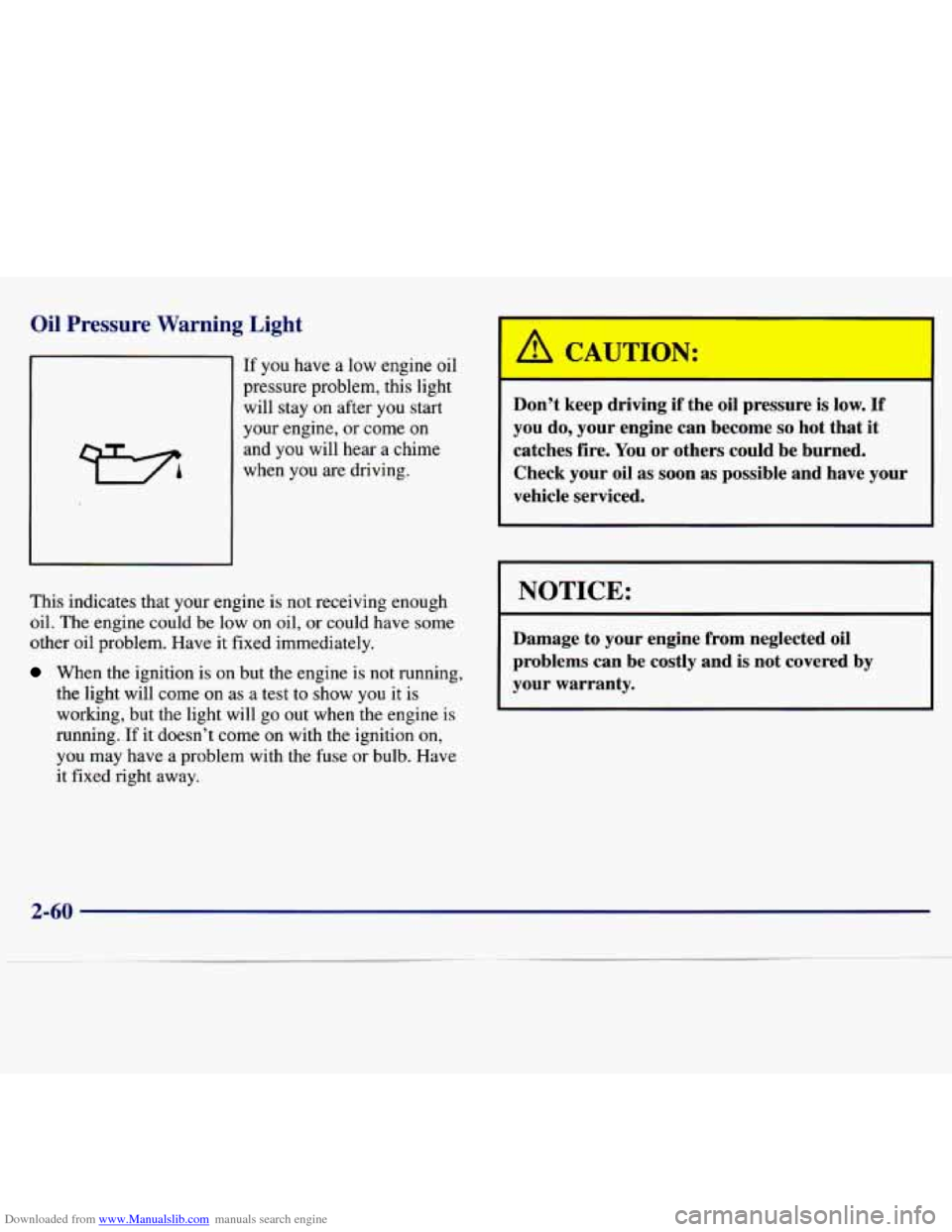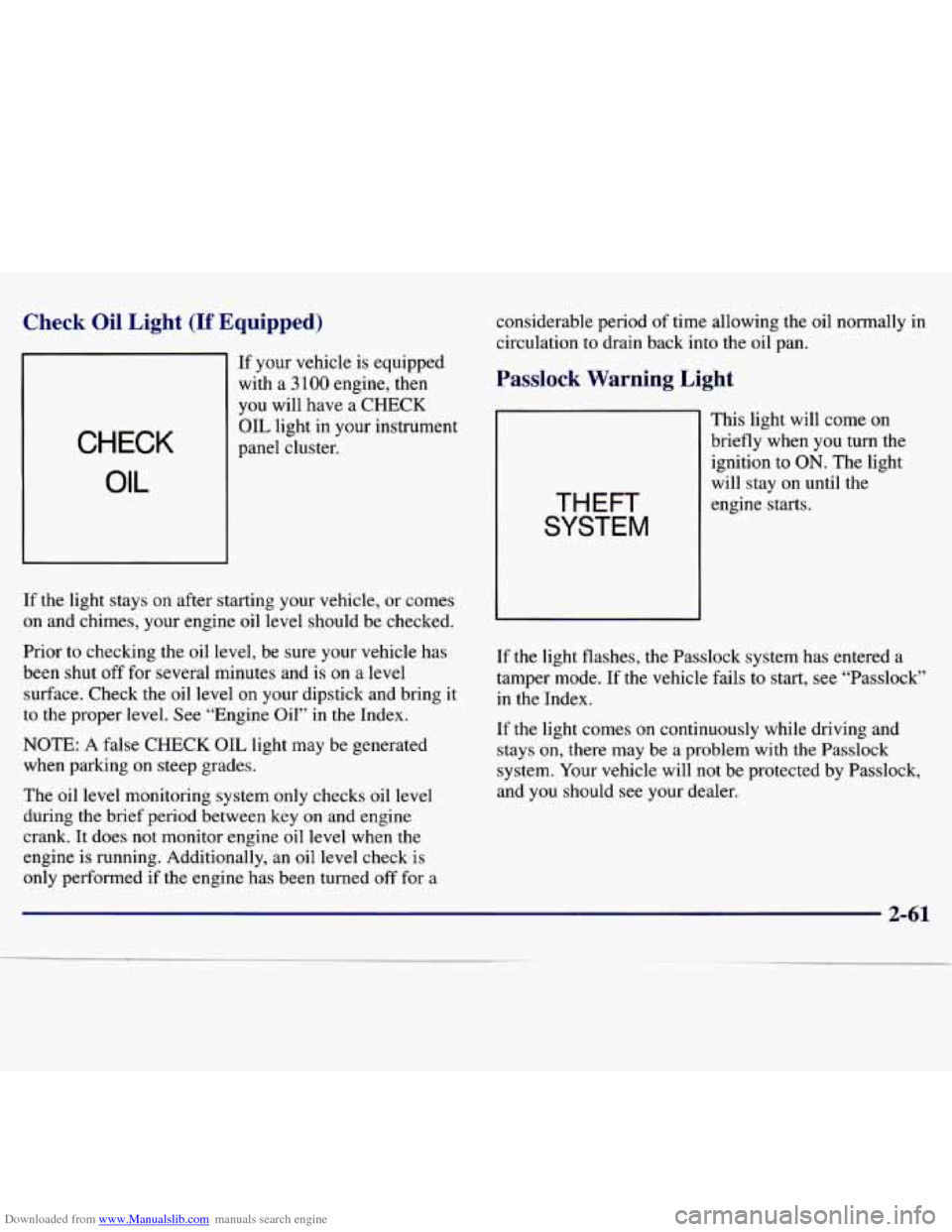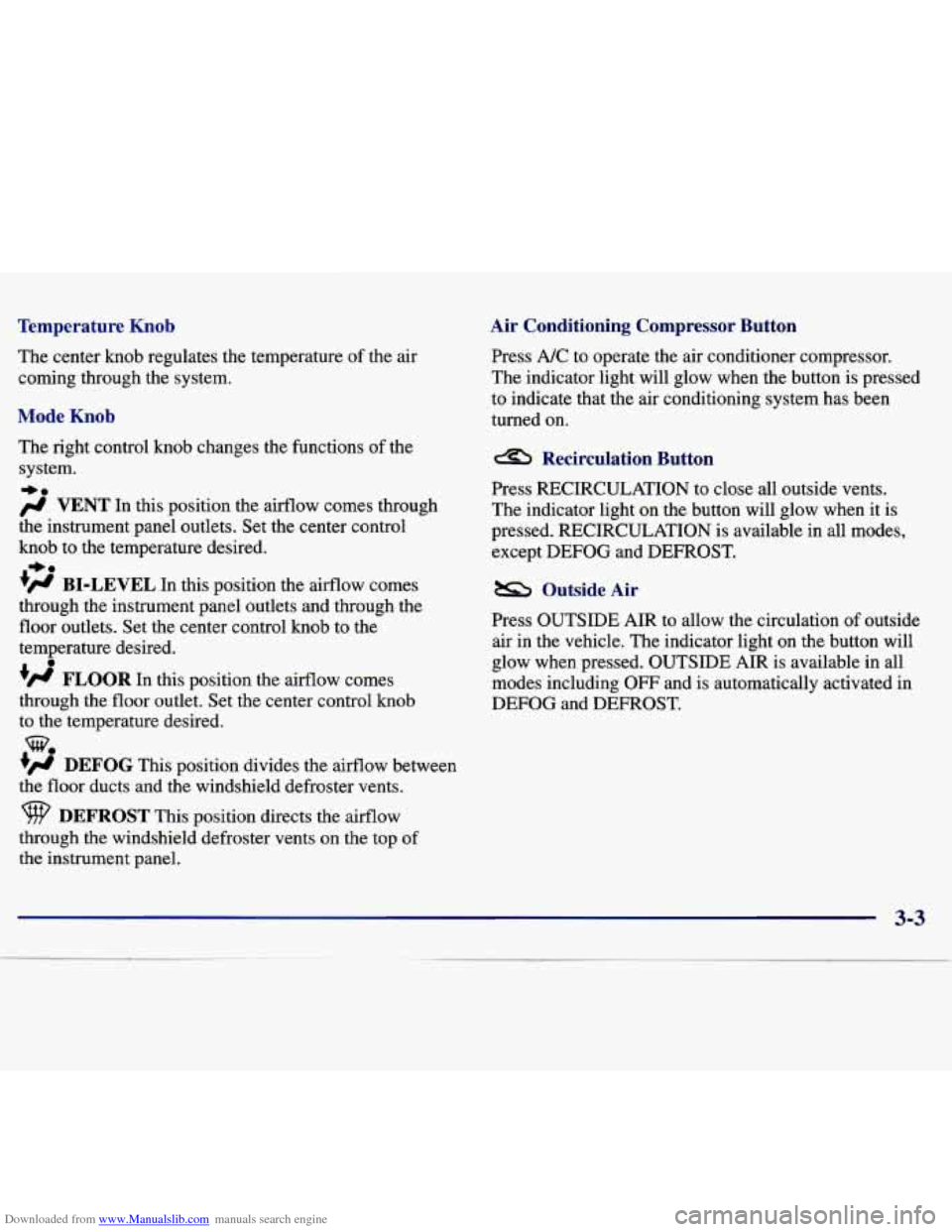Page 117 of 354

Downloaded from www.Manualslib.com manuals search engine Oil Pressure Warning Light
If you have a low engine oil
pressure problem, this light
will stay
on after you start
your engine, or come on
and you will hear a chime
when you are driving.
This indicates that your engine
is not receiving enough
oil. The engine could be low on
oil, or could have some
other oil problem. Have it fixed immediately.
When the ignition is on but the engine is not running,
the light will come on as
a test to show you it is
working, but the light will go out when the engine is
running.
If it doesn’t come on with the ignition on,
you may have a problem with the fuse or bulb. Have
it fixed
right away.
J:
Don’t keep driving if the oil pressure is low. If
you
do, your engine can become so hot that it
catches fire.
You or others could be burned.
Check your oil as soon as possible and have your
vehicle serviced.
I NOTICE:
Damage to your engine from neglected oil problems can be costly and is not covered by
your warranty.
2-60
Page 118 of 354

Downloaded from www.Manualslib.com manuals search engine Check Oil Light (If Equipped)
If your vehicle is equipped
with a
3 100 engine, then
you will have a CHECK
OIL light in your instrument
CHECK
OIL
panel cluster.
If the light stays on after starting your vehicle, or comes
on and chimes, your engine oil level should be checked.
Prior to checking the oil level, be sure your vehicle has
been shut
off for several minutes and is on a level
surface. Check the oil level on your dipstick and bring it
to the proper level. See “Engine Oil” in the Index.
NOTE: A false
CHECK OIL light may be generated
when parking on steep grades.
The oil level monitoring system only checks oil
level
during the brief period between key on and engine
crank. It does not monitor engine oil level when the
engine is running. Additionally, an oil level
check is
only performed if the engine has been turned off for a considerable period
of time allowing the
oil normally in
circulation to drain back into the oil pan.
Passlock Warning Light
THEFT
SYSTEM
This light will come on
briefly when you turn the
ignition to
ON. The light
will stay on until the
engine starts.
If the light flashes, the Passlock system has entered a
tamper mode. If the vehicle fails to start, see “Passlock”
in the Index.
If the light comes on continuously while driving and
stays on, there may be a problem with the Passlock
system. Your vehicle will not be protected by Passlock,
and you should see your dealer.
Page 119 of 354
Downloaded from www.Manualslib.com manuals search engine Cruise Light (If Equipped)
CRUISE
The CRUISE light comes
on whenever you set your
cruise control.
Low Washer Light
LOW
WASH
The LOW WASH
FLUID light will come
on
on briefly
when you turn
the ignition.
It will also stay on or come on and chime if the fluid
reservoir is
less than one-third full.
2-62
Page 120 of 354
Downloaded from www.Manualslib.com manuals search engine Service Vehicle Soon Light
SERVICE VEHICLE
SOON
Door
This light will come on
briefly when you turn
on the ignition.
It will stay on or come on and chime if it detects a
problem on the vehicle, such as a
DRL malfunction. If
this happens, see your dealer service department as soon
as possible. When
the ignition is on, this
light will stay on until all
doors
are closed and
completely latched.
You will hear a chime if a door is unlatched after the
engine is started and the vehicle is not in
PARK (P) or
NEUTRAL
(N). The chime will continue until the door
is latched properly.
2-63
Page 121 of 354
Downloaded from www.Manualslib.com manuals search engine Fuel Gage
Your fuel gage tells you
about how much fuel you
have left, when the ignition
is on. When the indicator
nears
EMPTY (E), the light
will come
on and you will
hear a chime. You still have
a little fuel left, but you
should get more soon.
Here are four things that
some owners ask about. None
of these show a problem with your fuel gage:
At the service station, the gas pump shuts off before
the gage reads
FULL (F).
It takes a little more or less fuel to fill up than the
gage indicated. For example, the gage may have
indicated the tank was half full, but it actually took a
little more or less than half the tank’s capacity to
fill
the tank.
The gage moves a little when you turn a corner or
speed up.
The gage goes back to EMPTY (E) when you turn
off the ignition.
2-64
Page 124 of 354

Downloaded from www.Manualslib.com manuals search engine Temperature Knob
The center knob regulates the temperature of the air
coming through the system.
Mode Knob
The right control knob changes the functions of the
system.
-0
/J VENT In this position the airflow comes through
the instrument panel outlets. Set the center control
knob to the temperature desired.
*H BI-LEVEL In this position the airflow comes
through the instrument panel outlets and through the
floor outlets. Set the center control knob to the
temperature desired.
+’ FLOOR In this position the airflow comes
through the floor outlet. Set the center control
knob
to the temperature desired.
+H DEFOG This position divides the airflow between
the floor ducts and the windshield defroster vents.
DEFROST This position directs the airflow
+o
e
we
through the windshield defroster vents on the top of
the instrument panel.
Air Conditioning Compressor Button
Press A/C to operate the air conditioner compressor.
The indicator light will glow when the button is pressed
to indicate that the air conditioning system has been
turned on.
Recirculation Button
Press RECIRCULATION to close all outside vents.
The indicator light on the button will glow when it is
pressed. RECIRCULATION is available in all modes,
except DEFOG and DEFROST.
Outside Air
Press OUTSIDE AIR to allow the circulation of outside
air in the vehicle. The indicator light on the button will
glow when pressed. OUTSIDE AIR is available in all
modes including
OFF and is automatically activated in
DEFOG and DEFROST.
3-3
Page 125 of 354

Downloaded from www.Manualslib.com manuals search engine Air Conditioning Heating
On cold
days, use FLOOR with the temperature knob
all the way in the red area. The system will bring in
outside air, heat it and send it to the floor ducts.
The
air conditioner and heater work best if you keep
your windows closed while using them. Your vehicle also has the flow-through ventilation system described
later in this section.
On very hot days, open the windows long enough to
let hot inside air escape. This reduces the time it takes
for your vehicle to cool down, which should help
fuel economy.
On cool, but sunny days, the sun may warm your upper
body, but your lower body may not be
warm enough.
You can use
BI-LEVEL with the temperature knob in
the middle and the A/C button pushed in. The system
will bring in outside air and direct slightly warmer air
to your lower body.
For quick cool-down on very hot days, use
VENT with
the temperature knob all the way in the blue area and the
A/C and RECIRCULATION buttons pressed. If this
setting is used for long periods of time, the air in your
vehicle may become too dry.
For normal cooling on hot days, use
VENT with the
temperature knob in the blue area and the
NC button
pushed
in. The system will bring in outside air and cool it.
Your vehicle has heat ducts that are directed toward the
rear seat. Keep the area under the front seats clear
of
obstructions so the heated air can reach the rear seat
passengers.
If your vehicle has an engine coolant heater, you can use it to help your system provide warm air faster when it’s
cold outside
(0°F (-18°C) or lower). An engine coolant
heater warms the coolant your engine and heating system use to provide heat. See “Engine Coolant
Heater” in the Index.
Defogging and Defrosting Windows
Your system has two settings for clearing the front and
side windows. For each setting, adjust the temperature
control as desired.
To defrost the windows quickly, rotate the temperature control knob
all the way in the red area. Use DEFROST
and adjust the fan to the highest speed. To warm
passengers while keeping the windows clean, use DEFOG.
3-4
Page 126 of 354

Downloaded from www.Manualslib.com manuals search engine Your vehicle is equipped with side window defogger
vents. The side window defogger vents are located on
the outside of the side instrument panel vents. For
additional side window defogging, rotate the mode
control to VENT, rotate the fan control to the highest
speed, press
A/C and aim the side vents on the
instrument panel to the windows. For increased
airflow to the side windows, close the center vents.
RECIRCULATION will not work in DEFROST and
DEFOG. This is done to prevent recirculation of humid
inside air and allow the system to work properly.
Rear Window Defogger (If Equipped)
I The rear window
defogger uses a warming
grid to remove fog from
the rear window. Press the defogger switch.
The indicator light will
glow. The rear window defogger will turn itself
off
after about 10 minutes after the first time the button is
pressed, and after
5 minutes each additional time the
button is pressed. You can turn the defogger off
by
pressing the button again or turning off the ignition.
Do not attach a temporary vehicle license across the
defogger grid on the rear window.
NOTICE:
Don’t use a razor blade or anything else sharp on
the inside
of the rear window. If you do, you
could cut or damage the warming grid, and the repairs wouldn’t be covered by your warranty.
3-5